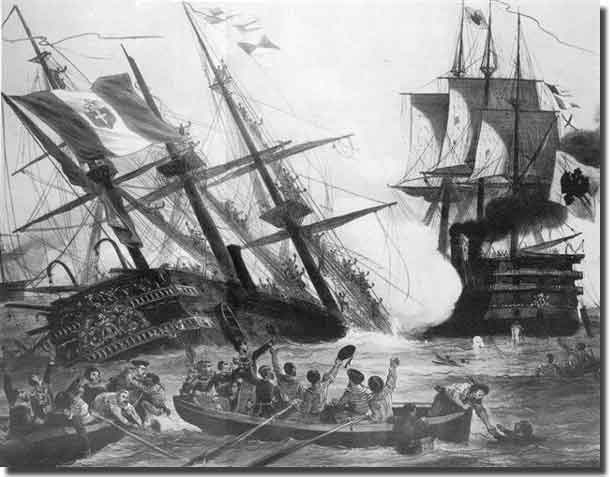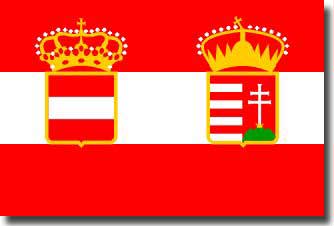|
The Genesis of the Austrian Navy.
Venice was founded on the 25th. of April 421 AD on St Marks day. In 726, Orso Ipato the first Doge there began his rule. 814: Found the first coins minted, and work started on the first Doge's Palace. 828: The body of San Marco is stolen from Alexandria by Venetian merchants. 1171: The first 6 districts of Venice are established. 1173: The first Rialto bridge is built. 1204: Venice takes part in the conquest and sacking of Constantinople, and the 4 bronze horses on display in front of S.Marco are plundered from Turkey. 1380: Venice defeats Genoa to gain supremacy at sea in the Adriatic and the Mediterranean. In the 14th. 15th. and even into the 16th. century Venice held sway over much of Europe, her conquests on the mainland at their peak by 1454. 1576: The plague struck, killing 50,000, and in 1630, a second wave of this disease accounted for yet another 46,000 Venetians. 1683: The Turks had advanced into the heart of Europe, and were threatening Vienna, and by 1718 the Peace of Passarowitz between Austria and Turkey, put an end to the fighting between Turkey and Venice, and it marked the end of the political domination of Venice in European affairs. Venice was now on the slippery slope of decline. 1748: The Peace of Aix-le-Chapelle now placed Austria in a dominant position of all the territories surrounding Venice. Over 1796/1797 Napoleon is on the march against Italy, and with the Treaty of Campoformido in October 1797, Venice is given to Austria by Napoleon. The Hapsburgs rule this city only until 1805 when it again changes hands and is returned once again to Napoleon, and the French rule for 10 years. But by 1815, Austria takes charge of Venice until 1848, when the people rebel, and proclaim a new Republic under Daniele Manin. But it is freedom for Venetians for but a short time, by August of 1849, Austria is again in control. 1866: The fate of Venice is finally decided by the outcome of the Third War of Independence, Venice goes to Napoleon 111 of France, and he in turn gives it to Italy, confirmed by a plebiscite of the populace of Venice themselves.
Sinking of Italian Red'Italia after being rammed The place of the Danube in the defence of Austria. The age of steam burst onto the world in 1830, and two British engineers, John Andrews and Joseph Pritchard started a shipyard in the Vienna suburb of Floridsdorf, launching the first Danube steamship, Franz 1.
Frigate Novara world voyage over 1857/1859. In addition to the Danube defence ships, Austria built up a blue water navy, based in Venice or at Pola, dependent upon who held sway over the city of Venice sitting at the top of the Adriatic. Italy had instituted a navy in 1861, and it came in conflict with the Austrians at the Battle of Lissa ( an island between land locked Austria and Italy, located in the Adriatic ) on the 20th. of July 1866, the Italians lost, their battleships Re d'Italia and Palestro, both being sunk.
This painting by Eduard Nezbeden in 1911 depicts the
Austria's first two screw Danube Monitors. The Whitehead - Luppis 14 inch torpedo.
von Trapp was a handsome Naval officer, who had commanded a submarine in the Austrian Navy, and it so happened that Robert Whitehead's great grand daughter Agathe Whitehead had been invited to launch a new submarine for the Navy. The pair met at the ceremony, fell in love, married, had 7 children. In 1922 Agathe died from scarlet fever. von Trapp married the children's governess Maria, and the musical "Sound of Music" came to be born. Today, one cannot visit Salzburg without being inundated with the romantic story of Maria, and her marriage to Georg von Trapp, let us not forget, he was a very intrepid and successful Submarine commander for the Austrian Navy in WW1. The politics of Central Europe prior to WW1. To counter act this alliance, the Triple Entente came into being, Britain, France and Russia. Planting the seeds of WW1 . France and Russia mobilized, Germany declared war on Russia and France, and when Germany marched into Belgium, then Britain joined the fray declaring war. At this early stage, Italy sat on the side lines remaining neutral, but Turkey, in October came in on the side of Germany, thinking they had picked the final winner. Finally, six months after the outbreak of WW1, Italy declared war on Austria/Hungary.
Austro-Hungary Navy Flag 1915-1918 Significant Austro-Hungarian Navy at start of WW1. In all, over the 1914/1918 war, some 17 of the above ships were sunk. The submarines of this fleet had a good deal of success, damaging the French Dreadnought Jean Bart, they sank a French and Italian Armoured cruiser, a British Destroyer, and 2 French and 2 Italian Destroyers, plus a French and Italian Submarine. At War end, the Austro/Hungarian ships were divided up between the victorious Allies. When the 1914/1918 war came to an end, the remaining ships of the Austro-Hungary Navy were divided up between the Allied Nations,to the old tried and true adage "To the victors the spoils!" The time of Austria-Hungary being a Maritime nation, had at last, come to an end.
|





